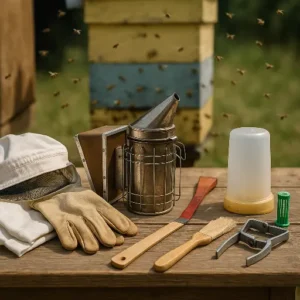The Beekeeper’s Toolbox – Essential Tools Every Apiculturist Must Own
Introduction
In the world of beekeeping, having the right tools is as crucial as understanding the bees themselves. Whether you’re a beginner or an experienced beekeeper, your success heavily depends on the quality and completeness of your beekeeper’s toolbox. In this post, we’ll explore the must-have beekeeping tools, their functions, and why each is vital for hive management.
Essential Tools for Every Beekeeper
1. Bee Suit and Gloves
Protective gear is your first line of defense. A full-body bee suit, veil, and leather gloves protect you from stings and let you work confidently.
2. Hive Tool
A flat, sturdy piece of metal used to pry apart hive components, scrape wax or propolis, and lift frames. It’s like a beekeeper’s Swiss Army knife.

3. Smoker
Used to calm bees by masking alarm pheromones. A smoker is essential when opening the hive, conducting inspections, or harvesting honey.
4. Bee Brush
Soft-bristled brush used to gently remove bees from frames without harming them. Especially useful during inspections or honey extraction.
5. Frame Grip
Helps in lifting frames from deep hive boxes, especially useful when they are sticky or full of honey.
6. Uncapping Knife or Fork
When it’s time to extract honey, you need a way to uncap sealed honeycombs. Heated knives or forks are standard tools for this job.
7. Queen Catcher & Marker
To identify and track the queen, a queen catcher and marker pen make it easier to locate her during inspections.
8. Feeder
A feeder allows you to supplement your bees’ diet with sugar syrup during times when nectar is scarce.
Bonus Tips for Beekeepers
- Keep your tools clean and dry to avoid spreading disease among hives.
- Invest in quality items instead of cheap plastic tools — they last longer and perform better.
- Always inspect your kit before heading to the apiary to ensure nothing important is missing.
Internal Link Suggestion
Explore premium beekeeping equipment on our store:
👉 Visit BeekeepingIndia Shop
Conclusion
The journey of “The Beekeeper” begins with preparation. With these tools by your side, you’re ready to manage your hives efficiently, ensuring health and productivity for your bees. Stay tuned for tomorrow’s post in our daily series!

One Comment
Comments are closed.